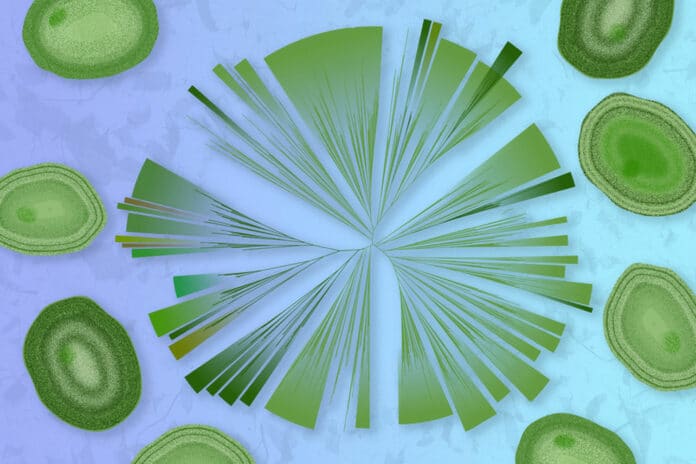Prochlorococcus is the smallest and numerically most abundant cyanobacterium in the oceans. It has a large pangenome and hypervariable genomic islands linked to niche differentiation and phage defense. The smallest and most numerous cyanobacterium in the oceans is Prochlorococcus.
According to recent research by MIT, these microscopic bacteria communicate with one another by a previously unidentified mechanism, even when they are far apart. Because of this, they can pass along entire gene sets, such as those enabling them to assimilate a certain type of nutrition or protect themselves against viruses, even in areas where their population in the water is quite low.
According to the findings, a new class of genetic agents involved in horizontal gene transfer—in which genetic material is directly transferred across animals, whether they are of the same species or not—has been discovered by methods other than lineal descent. Tycheposons are DNA sequences that can spontaneously detach from surrounding DNA and can include multiple complete genes, according to scientists.
Tycheposons are the agents that carry out this transfer. They can then be delivered to other creatures through various carrier systems, such as the vesicles that cells can create from their membranes.
For the study, scientists studied hundreds of Prochlorococcus genomes from different ecosystems around the world, lab-grown samples of different variants, and even evolutionary processes were carried out and observed in the lab.
Institute Professor Sallie “Penny” Chisholm said, “We’re very excited about it because it’s a new horizontal gene-transfer agent for bacteria, and it explains many of the patterns we see in Prochlorococcus in the wild, the incredible diversity. Now thought to be the world’s most abundant photosynthetic organism, the tiny variants of what is known as cyanobacteria are also the smallest of all photosynthesizers.”
MIT postdocs Thomas Hackl said, “The work began by studying the 623 reported genome sequences of different species of Prochlorococcus from different regions, trying to figure out how they were able to so readily lose or gain particular functions despite their apparent lack of any of the known systems that promote/boost horizontal gene transfer, such as plasmids or viruses known as prophages.”
Scientists investigated islands of genetic material that seemed to be hotspots of variability and often contained genes associated with known key survival processes such as the ability to assimilate essential, and often limiting, nutrients such as iron, nitrogen, or phosphates.
These islands comprised genes that differed greatly among species but consistently occurred in the same regions of the genome and occasionally were almost identical even in very different species, which is strong evidence of horizontal transfer.
However, the genomes lacked typical characteristics connected with so-called mobile genetic components, thus, this initially remained puzzling. The fact that this gene transfer and diversity system was distinct from the many other mechanisms seen in other creatures, including humans, gradually became clear.
When DNA fragments were bundled together in ways that could almost immediately bestow the capacity to adapt to a given environment, Hackl likens what they discovered to a genetic LEGO set. For instance, a species constrained by the availability of a certain nutrient may acquire the genes required to improve the intake of that nutrient.
Hackl says, “The microbes appear to use a variety of mechanisms to transport these tycheposons (a name derived from the Greek goddess Tyche, daughter of Oceanus). One is the use of membrane vesicles, little bubbles pouched off from the surface of a bacterial cell and released with tycheposons inside it. Another is by “hijacking” virus or phage infections and allowing them to carry the tycheposons with their infectious particles, called capsids. These are efficient solutions because, in the open ocean, these cells rarely have cell-to-cell contacts, so it’s difficult for them to exchange genetic information without a vehicle.”
“And sure enough, when capsids or vesicles collected from the open ocean were studied, “they’re quite enriched” in these genetic elements. The packets of useful genetic coding are “actually swimming around in these extracellular particles and potentially being able to be taken up by other cells.”
Chisholm says that “in the world of genomics, there’s a lot of different types of these elements” — sequences of DNA that are capable of being transferred from one genome to another. However, “this is a new type,” she says. Hackl adds that “it’s a distinct family of mobile genetic elements. It has similarities to others but no tight connections to any of them.”
“While this study was specific to Prochlorococcus, Hackl says the team believes the phenomenon may be more generalized. They have found similar genetic elements in other, unrelated marine bacteria but have not yet analyzed these samples in detail. Other bacteria have described similar elements, and we now think they may function similarly.”
“It’s a plug-and-play mechanism, where you can have pieces that you can play around with and make all these different combinations. And with the enormous population size of Prochlorococcus, it can play around a lot and try many different combinations.”
Nathan Ahlgren, an assistant professor of biology at Clark University who was not associated with this research, says, “The discovery of tycheposons is important and exciting because it provides a new mechanistic understanding of how Prochlorococcus can swap in and out new genes, and thus ecologically important traits. Tycheposons provide a new mechanistic explanation for how it’s done. They took a creative way to fish out and characterize these new genetic elements’ hiding’ in the genomes of Prochlorococcus.”
Journal Reference:
- Thomas Hack, Raphaël Laurenceau, et al. Novel integrative elements and genomic plasticity in ocean ecosystems. Cell. DOI: 10.1016/j.cell.2022.12.006
